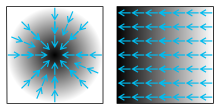Gradient
The gradient as an operator of mathematics generalizes the known gradients, which describe the course of physical quantities. As a differential operator, it can be applied to a scalar field, for example, and in this case will yield a vector field called a gradient field. The gradient is a generalization of the derivative in multidimensional analysis. To better distinguish between the operator and the result of its application, such gradients of scalar field quantities are also called gradient vectors in some sources.
In Cartesian coordinates, the components of the gradient vector are the partial derivatives at the point 
For example, if one interprets the relief map of a landscape as a function 



The gradient is studied together with other differential operators such as divergence and rotation in vector and tensor analysis, subfields of multidimensional analysis. They are formed with the same vector operator, namely the Nabla operator 



Two scalar fields, displayed as gray shading (darker color corresponds to larger function value). The blue arrows on them symbolize the corresponding gradient.
Definition
On 




uniquely determined vector 

For differentiable functions gradient has 
![{\displaystyle f({\vec {y}})-f({\vec {a}})=\mathrm {grad} f({\vec {a}})[{\vec {y}}-{\vec {a}}]+{\mathcal {O}}(|{\vec {y}}-{\vec {a}}|)}](https://www.alegsaonline.com/image/30f191d47d7f6e362c9c9d472888796b970a1d30.svg)
The Landau symbol 

![{\displaystyle \ldots [{\vec {h}}]}](https://www.alegsaonline.com/image/04ca99ddbb4750a35cee3d794c2f93d1c75d4501.svg)

where 
For a scalar field, it follows that 



Coordinate representation
The gradient also has different representations in different coordinate systems.
Cartesian coordinates
In 

The entries ∂ 


Calculation example
Given a scalar field by 



For example, for the point 


Cylinder and sphere coordinates
- Display in three-dimensional cylindrical coordinates:
- Display in three-dimensional spherical coordinates:
These are special cases of the gradient on Riemannian manifolds. For this generalization see: Outer derivative.
Orthogonal coordinates
In general orthogonal coordinates the gradient has the representation
where the 

General curvilinear coordinates
In general curvilinear coordinates the gradient has the representation
where 
Geometric interpretation
The gradient has a descriptive meaning in the already mentioned case of (two-dimensional) maps, in which height data are registered. The height function is then a scalar field, which assigns a height to each point on the map (characterized by an x- and a y-coordinate). The gradient of this scalar field at a point is a vector pointing in the direction of the steepest slope of the height function, and the magnitude of the gradient corresponds to the magnitude of this slope. The gradient at any point is perpendicular to the contour line (level line) of the height function through that point. In a local minimum or maximum (extremum) or at a saddle point, the gradient is just the zero vector, provided that this extreme point lies in the interior of the considered area.
With the help of the gradient, the increase in any direction can also be determined. This so-called directional derivative is - in contrast to the gradient - a scalar. If one runs in the area in (infinitesimally) small triple steps from a point a to the point b and sums up the product of step length and direction derivative in direction of the step, one receives as result the height difference to the starting point a at the destination point b. This height difference is obviously path independent. This height difference is obviously path-independent. In particular, if the start and end points coincide, one has not changed one's altitude at the end, no matter which path one has taken through the area.
Applications
Conservative forces
→ Main article: Conservative force
In physics, many force fields can be represented as the gradient of a potential. Examples are:
- the gravitational force
which is the same as for a central mass M
is, or
- static electric fields
in electrodynamics
In conservative force fields, one of the factors exploited is that, for sample masses or sample sample loads the path integrals the work 

Transport phenomena
Numerous transport phenomena can be traced back to the fact that the associated currents can be expressed as a gradient of a scalar field, with the proportionality factor that occurs being referred to as the transport coefficient or conductivity.
An example is the heat flow 
where λ is 
In fluid mechanics, a potential flow is a flow in which the velocity is a gradient of a potential field, see velocity potential.
Image processing
→ Main article: Edge detection
One problem in image processing is to detect contiguous areas in an image. Since an image contains discrete values, filters like the Sobel operator are used to obtain a gradient field of the image. A filter is a matrix that is used to convolve the image (see Discrete Convolution). The edges in the image are then recognizable as extreme values of the filtered image.
More applications
- Just as Gauss-Newton methods are used for finding zeros of functions, the gradient method is used for multidimensional optimization problems in numerics.
- A pressure gradient microphone exploits the pressure differences between spatial points.
Generalizations
Gradients of vectors and tensors
See also: Gradient of a vector field
As already noted in the #Definition section, the gradient is also applied to vectors and tensors. Gradient of a scalar field (zero level tensor field) results in a vector field which is a first level tensor field. In general, gradient of a tensor field of nth degree leads to a tensor field of degree n+1.
The coefficients of the gradients of the covariant basis vectors of a curvilinear coordinate system are the Christoffel symbols.
Especially in continuum mechanics and fluid mechanics the gradients of scalar and vector fields are used in many ways, because the above #properties can be easily transferred to gradients of vector fields.
Riemannian manifolds
For a smooth function 




where 











where 


In local coordinates the gradient has the form
Analogous to the case 
More precisely, 


corresponding vector field. The relation between outer derivative and gradient for functions on the 
Search within the encyclopedia


![{\displaystyle \mathrm {grad} f({\vec {a}})[{\vec {h}}]=\left.{\frac {\mathrm {d} }{\mathrm {d} s}}f({\vec {a}}+s{\vec {h}})\right|_{s=0}=\lim _{s\to 0}{\frac {f({\vec {a}}+s{\vec {h}})-f({\vec {a}})}{s}}=({\vec {h}}\cdot \nabla )f}](https://www.alegsaonline.com/image/2652706894e56c5f17a4fea9ebd271ea00dd614b.svg)


















